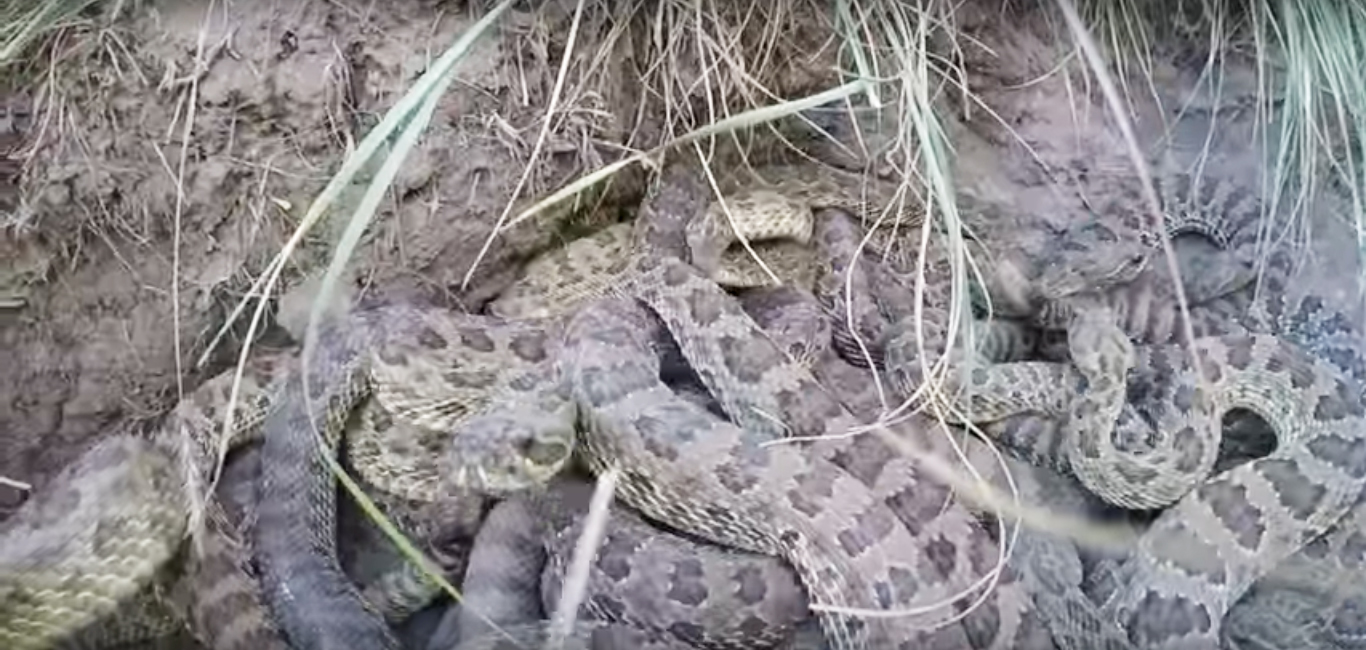When the weather turns brisk and chilly during winter, who among us doesn’t like the snug warmth and comfort of our dens? Rattlesnakes are no exception. But rattlesnake “denning” is less hot chocolate and cozy quilts on the couch and more slithering, rattling mounds of pit vipers. Indeed, DesertUSA.com, a website for “those who love the desert,” didn’t mince words when defining rattlesnake denning:
“With the coming of the shortening days and falling temperatures of autumn, the western diamondbacks head for the community den – a cave or rocky recess – where they will hibernate for the winter. In colder areas, they come by the hundreds; in warmer areas, by the dozens. They emerge in spring, sexually driven, hungry and mean.”
In Texas, there are actually eight (or nine or ten, depending on who you ask) species of rattlesnakes, ranging from the western pygmy rattlesnake, no more than about 18 inches long, to the western diamondback rattlesnake, which can grow to 5 or 6 feet in length. Of these, the most common rattlesnake in Texas is the latter that, along with the prairie rattlesnake, is a communally denning species. According to the Nature Conservancy, snakes often return to the same den year after year, migrating to hunting territories after waking.
According to the Internet Center for Wildlife Damage Management:
“The activity period for rattlers can vary from about 10 months or so in warm southern regions to perhaps less than 5 months in the north and at high elevations. Depending upon availability of good, dry denning sites below the frost line, rattlesnakes may hibernate alone or in small numbers. However, sometimes they den in large groups of several hundred in abandoned prairie dog burrows or rock caverns, where they lie torpid in groups or ‘balls.’ All dens must be deep enough so the temperature is not affected by occasional warm days. If not, the snakes might emerge too early in spring only to become sluggish and vulnerable should the weather again turn cold.”
Not surprisingly in Texas, where warm weather spikes in winter are common, the rattlesnake’s winter dormancy may be periodically interrupted. While we’re turning on the air-conditioner for Christmas or enjoying margaritas on the patio in t-shirts and shorts in January, the rattlesnake may be venturing out for a sunny day slither.
Rattlesnake roundups
While denning is a survival tool for rattlesnakes, it has also played a role in their demise as rattlesnake hunters spray gas into the dens to force them out with the fumes, allowing for the quick capture of many. Although the practice of gassing is banned in 29 states, beginning in January, “rattlesnake roundups” take place in several states where it is still legal, including Texas, home to the “World’s Largest Rattlesnake Roundup” in Sweetwater.
Because rattlesnake gassing is considered cruel by some, as well as a potential environmental hazard to wildlife habitat, non-target animals, and humans, and could negatively impact ecosystems where the snakes play a key role including controlling rodent populations, the issue on whether it should be banned in Texas has been an ongoing point of debate. In December 2014, Texas Parks and Wildlife Department (TPWD) convened a Snake Harvest Working Group to delve into this issue. At their May 25, 2016 meeting, the TPWD Commission requested that staff prepare language for a proposed rule addressing gassing. This proposal was to be presented to the Commission for consideration at their November 2016 meeting, but was ultimately dropped from the agenda, leaving rattlesnake gassing still legal in Texas. The Sweetwater roundup, which brought in close to 25,000 pounds of rattlesnakes last year, is this year set for March 10-12, 2017.
What to do if you stumble upon a den of rattlesnakes?
The thought of just happening upon a “ball” of rattlesnakes seems unlikely, but in Five Things I Learned While Mapping Rattlesnake Dens, blogger Natalie Kuehler describes:
“2. A Rattlesnake’s Rattle is Surprisingly Muted. I had seen plenty of rattlesnakes before, but never heard one rattle. I was told you will never mistake that sound: it chills you to the bone. So imagine my surprise when, while I was marveling at the crickets chirping all around me, the Forest Service biologists froze in his tracks and looked around. We were standing in the middle of a denning site, and my crickets were snakes, cautiously alerting me to their presence.”
Here are the general rules of thumb for a rattlesnake encounter:
- Freeze in place until its position can be located. If you can’t see it, you may move closer to it. And, even if you can see it, by freezing you will reduce the threat you pose to the snake.
- Try to establish a safe distance of at least five feet from the snake. If possible, move slowly back the way you came.
- Leave the snake alone. Reportedly, one-third of people who suffer snakebites were bitten when trying to handle or kill it.
And, don’t post about it on Facebook until after you’re far, far away.
To see rattlesnake denning about as up close and personal as you should ever want to be, check out this video on YouTube.









